-
Start
-
Bears Town
-
Sansawon
-
Pocheon Dongjanggun Festival
-
Pocheon HanwooMaeul
-
Pocheon Art Valley
-
Hotel Nine
-
Harbor Coffee
-
Dasan Historic Site
-
Finish
The Gallery Sansawon
Although Gyeonggi-do was quite close to our destination, the reason we started off early was because of this destination I’m going to introduce. One of things that remind you when you think of Pocheon must be alcohol.

And there’s Baesangmyun Brewery’s Sansawon in Pocheon that is an exhibit that represents alcohol in Pocheon. Sansawon located in the inner of east area in Pocheon is quite far away from main road in downtown so it’s quite uncomfortable to get there by public transportation. Probably one bus every hour?

Walk along the two-lane road in a small countryside until you get to the narrow alley to the mountain road, then you’ll see a little bit shabby brown building. It’s not our destination but it is one of biggest alcohol companies called Josuldang.

And the opposite side is lawn with so many pots and a few buildings under the warm winter sunlight.

This is, in deed, our first visit area, Sansawon and Sansajeongwon(Sansa Garden). The laboratory or distribution materials factory was not open to the public.

At the entrance to Sansawon, there was a small signboard that shows you the map of Sansawon as a guide. The place looks quite large. I assume the time would fly just by looking around Sansajeongwon.

It’s still cold so let’s look around inside the building. Oh…by the way is this the entrance? There was nobody else. We got blow off a few times so we were scared. ‘Don’t tell me today’s off.’

Then we were relieved to see the sign on the front door. Well, I didn’t expect a fancy building but I thought there would be a ticketing office at least …

Plus, they open the gate only after I rang the bell. I felt like I was visiting my friend next door… There was a special event signboard on the lobby welcoming us. I didn’t see anything else but ‘free taste’ and ‘sample.’ Yahoo~~
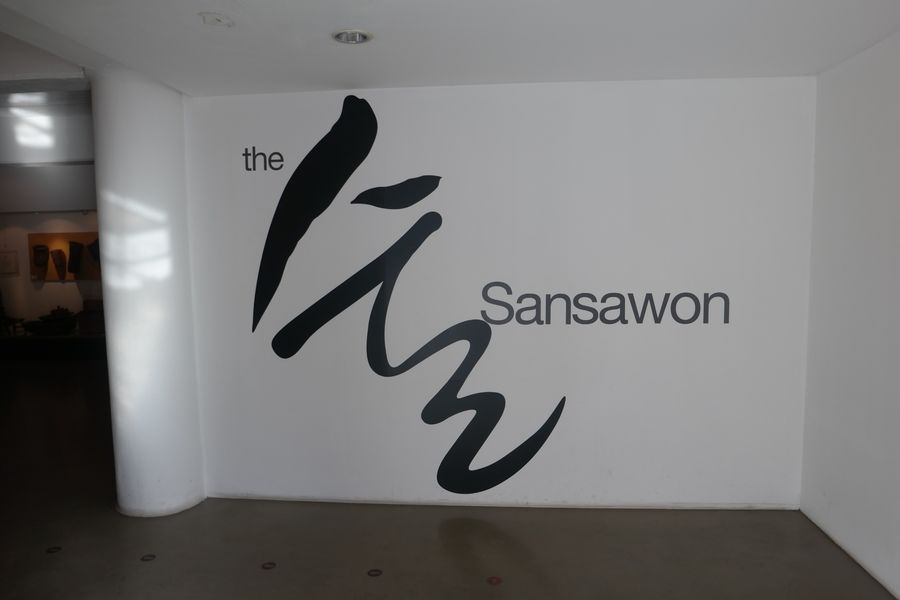
A simple letter ‘Sul(alcohol)’ was written on the front wall. It’s one of Korean words that its form matches so well with its meaning. Sul~drinking alcohol sulsul(easily).

On the first floor of Sansawon, there’s a museum showing the history of alcohol, tools used to make alcohol and processing techniques. They’re divided by each theme.

You’ll see the first things you see are tools that are used to make alcohol just by the look of it. The thing that looks like sand on the right might be the raw material of alcohol called yeast.

The strange and big pots are used to make distilled water, a kind of alcohol that has relatively transparent color.
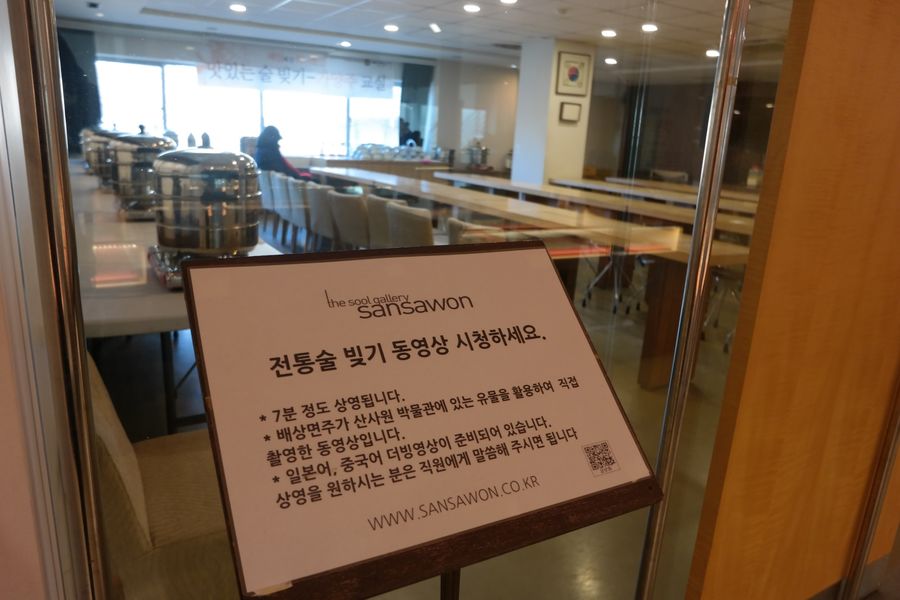
There is a small classroom in one corner. It’s used as a classroom and a kitchen where you can see the movies of process that make alcohol by using traditional relics. I guess it would be also nice for foreigners since the movies are available in Chinese or Japanese language.

Plus if you make it on time, you could also make alcohol by yourself so it seems like a good place to try different activities.

One side of wall is filled with processes and principles of everything. But the words were difficult than I had expected. Deotsul, Sulmil, Jaegang…I’ve never heard of them..

But no matter what anybody says, alcohol is the better when you let other people make it and drink it yourself on the floor comfortably with lots of snacks than making it by yourself~!!

Plus, just like each alcohol has different taste and flavor, you gotta use different cup for each. So when it comes to Makgeolli, you gotta drink it in this big bowl.

There are a few phrases of story about alcohol on white walls outside the video room quoting from literatures. It feels like each one matches with each theme. And it made me feel like I should’ve drank already.

I would’ve drunk alcohol if it was night but since it was early in the morning…I had to put myself together and kept looking around the exhibit.

Most of the items were from the late Joseon Dynasty era or Japanese colonial era, not the ones from old old time like any other museums do.

They were used until a few decades ago. That’s why I got a strong sense of familiarity from items? I indeed felt I’ve seen some bottles like that one made in Japanese colonial era somewhere.

On one side of walls, there’s a map of famous traditional alcohol South Korea. It’s only a few but I’ve tried less than I had expected…Wow I gotta step up(?)!

Not only our ancestors, but also the whole eastern cultures consider alcohol as ‘style.’ So you cannot talk about ‘taste for the arts’ without mentioning alcohol.

A few display cupboards were full of glasses in different shapes and colors. They say names and natures do often agree, which means each alcohol tastes different in different glasses, and that made me wonder how each would provoke the taste for the arts as well.
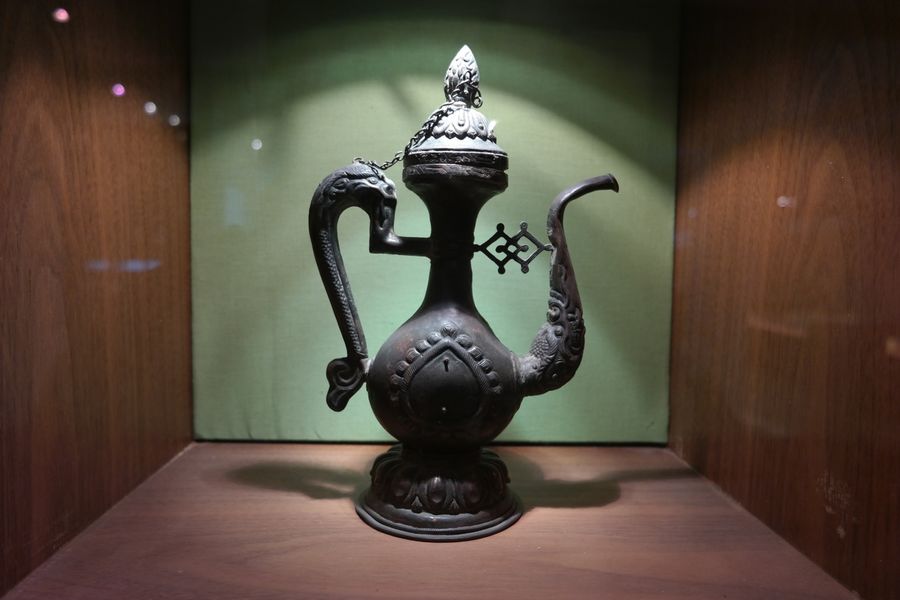
This one doesn’t look like it’s from Korea or any other country near Korea.I assumed this strange shaped bottle is from Arabic country but I couldn’t find out about its origin.

There were other bottles of alcohol that looked exotic but with no description, which was a little disappointing.

Then I realized something. Anything with some sort of description would be more important one right? Then I noticed a table of drink, snacks and cup inside the big glass.

It says the table and cup were made of 200 years old may tree struck by lightning. A tree struck by lightning has been considered as holy since a long time ago. Maybe that’s why it became such special cup and table.

There are many important things when making alcohol but the most important thing is water. Lastly, they were explaining common and different things with tea, which is another type of taste for the arts yet made of same ingredients, reminded us that we need to enjoy alcohol but the cup should not be overflow.

In the middle of exhibition room, there’s a big sculpture that turns slowly around. Small dolls show the process of making alcohol. But it was not easy to understand it by the look of it.

If you want to hear the whole story, you’d have to take a look around other exhibits and then move to inner side where the voice comes out that explains each situation.

In the end of the room, there are old furnitures in different shapes in a row. It’s an old storage tray called a wooden rice chest. We could see our ancestors’ sense of beauty from pieces of art made of very simple items. Moreover, there’s an old refrigerator made of woods, which is strange, so you shouldn’t skip anything.

This leads to downstairs. A few famous alcohols were hung on the walls along with the bronzes of hands of celebrities who were in the ad for alcohol that is still on sale. All I could think was that the hands were smaller that I expected but I say they use the space very efficiently.

The first thing you’ll see downstairs is a big bar. On the square bar that is open every direction, there were different kinds of alcohol. And you can taste anything there. Muhahahaha~

Well, we’ve got to finish viewing before tasting. Not so far from the stairs, there were famous traditional alcohols in Korea with explanations. To see them displayed like this, there were more kinds of it than I had imagined.

And you cannot miss snacks when you drink. There was a table of snack served with alcoholic beverages that were trivial and folksy as well as another table that seemingly is for lords. And they looked pretty real for an imitation that made me drool.

I have been drinking for a long time but I never heard that the snacks are different depending on alcohol here. There must be different types of snacks that go with each type of alcohol, not just their preference, since a long time ago.

As we stopped drooling and turned back, we saw numerous pots stuck in the glass. It’s a ripening refrigerator to make the cleanest and strongest distilled liquor made here.

This place not only offers explanations of general meaning and process of liquor but it also displays and sells liquors.
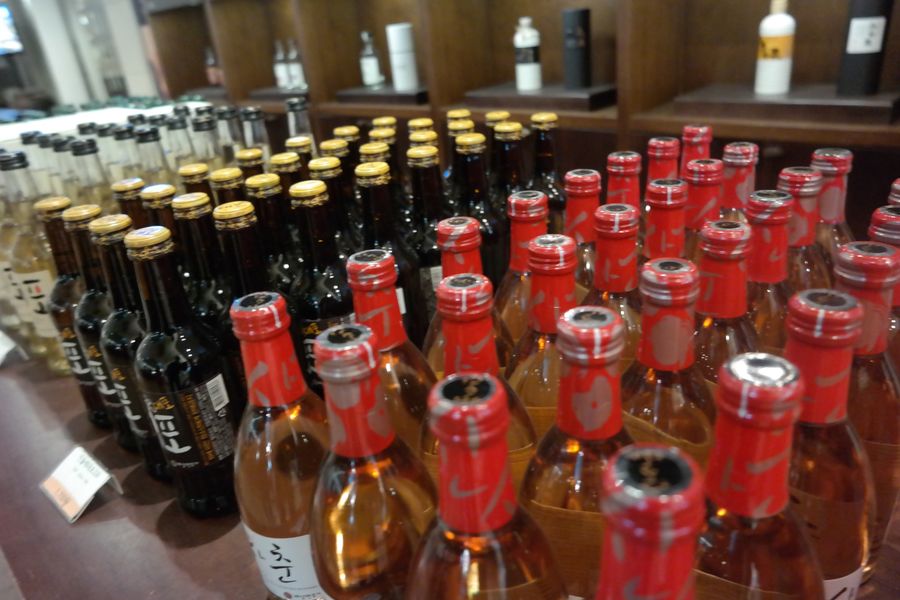
I could see familiar alcohols that have been popularized such as Daepo and Sansachun. These are more like medicinal liquor with the scent of medicinal herbs. If you look around the area, there are pretty bottles of liquor including Makgeolli.
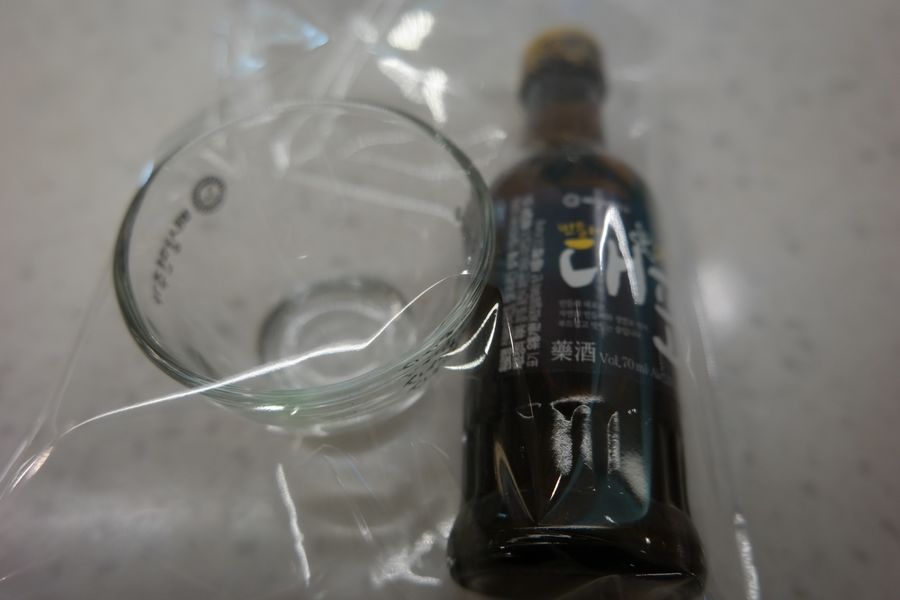
When you are about to finish viewing, you’ll finally see the place where you submit the ticket. I don’t know if the fees are for sampling or watching but once you pay, you’ll be given a pretty cup and a miniature bottle of liquor. YESSSS~!!

Now the highlight of this place begins. We stood close to the bar and started sampling the liquors. There are so many kinds of liquor so even if you sample one cup for each one, you’ll get drunk so you should be careful.

The first thing I saw was liquors stored in a heating cabinet. These are mostly medicinal liquors. And crude liquor, a part of exhibition, is also stored here.

And the red liquor called Cheondaehongju is in an ice bucket. This traditional alcohol was reappeared 300 years after based on a book titled Imwonsipyukji(林園十六志) and it goes well with baked fish and meat.
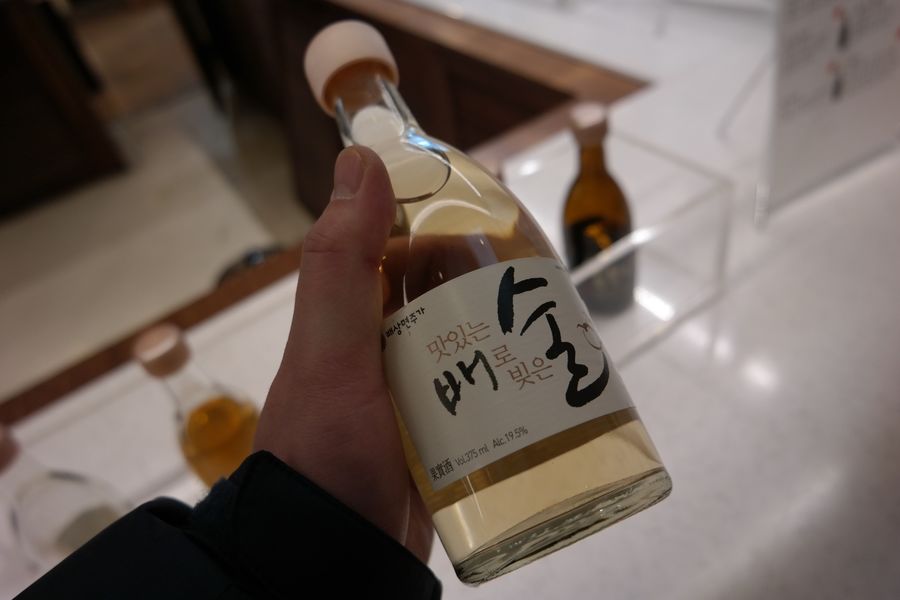
And there are many kinds of liquor made with various fruits. The thing I liked the most is ‘liquor flavored with delicious pear’ that you could imagine its taste even by hearing its name.

It’s 19.5 degrees liquor, which is quite high, but I had one because of cold weather and my cold. I could feel gentle scent of pear and a bit sweetness but it was alcohol indeed~

Other than medicinal liquors, there was Makgeolli in one corner that is also known as raw rice wine. Strangely it was light pink since it had blueberries.

Makgeolli should be served in this bottle and a big bowl…I was dying to drink it in a bowl.

I had no choice but to taste it in the given cup so I did and it wasn’t so bad to see its light pink look in the transparent cup.

Among dozens of liquor bottles that are offered for tasting, I liked this Bingtanbok the most. The bottle says it’s carbonated raspberry wine matured at a low temperature, a type of fruit wine. I should say it’s a bit sweet wine? I bet ladies would love this.

It’s sampling but just when I was about to get bored with liquors, I found out there were snacks on the table to the right.

They were not fancy as a banquet but there were a few snacks including spicy and crispy snacks. Especially this long snack tasted very nice.
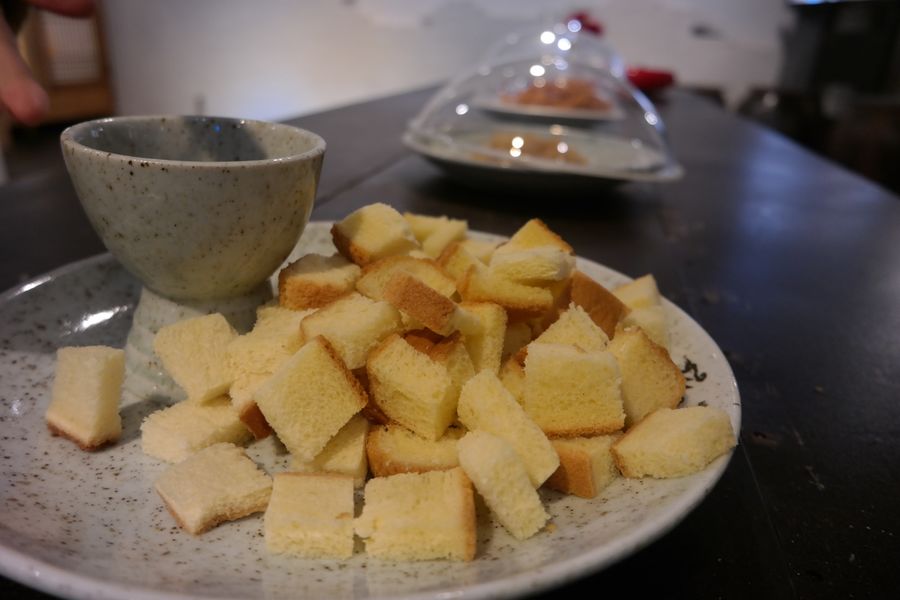
This sauce is sweet and sour that you can dip a piece of bread. But you should be aware that these snacks are made of Suljjigaemi, which is also related to liquor. So you would be eating alcohol for a snack after drinking alcohol.

Leaving my camera closed, I was going around to have a sip or two, I felt like I was getting drunk but I think it helps me get over the cold breeze outside.

We left the room with red cheeks and walked along the hallway connected to outside. There were tools and explanations about the process of making liquor on both sides of the hallway.

I don’t know if it is working but as the sign says ‘caution for burn,’ these strangely-shaped equipments must be working.

You shouldn’t skip this after sampling because you would be missing important exhibit since there are tools and explanations about detailed processes and methods that you could not see in the exhibition room. Plus you can take a closer look at the tools that are actually used here.

At the end of the hallway, there are interesting posters hung on the walls for modern people and modern society rather than regarding it as relics of the past.

It also says that a famous TV program Infinite Challenge was filmed here. I was glad to see the autographs of Yu Jae-seok, Jeong Hyeong-don and others.

After a quite long tour at Sansawon, we headed to another attraction, Sansajeongwon(Sansa Garden). Sansajeongwon area was still covered with snow for a few days.

In one corner of the garden, there are old tools and large equipments that seemed to be used in the old movies but they were not recognizable probably because they were outside and not organized.
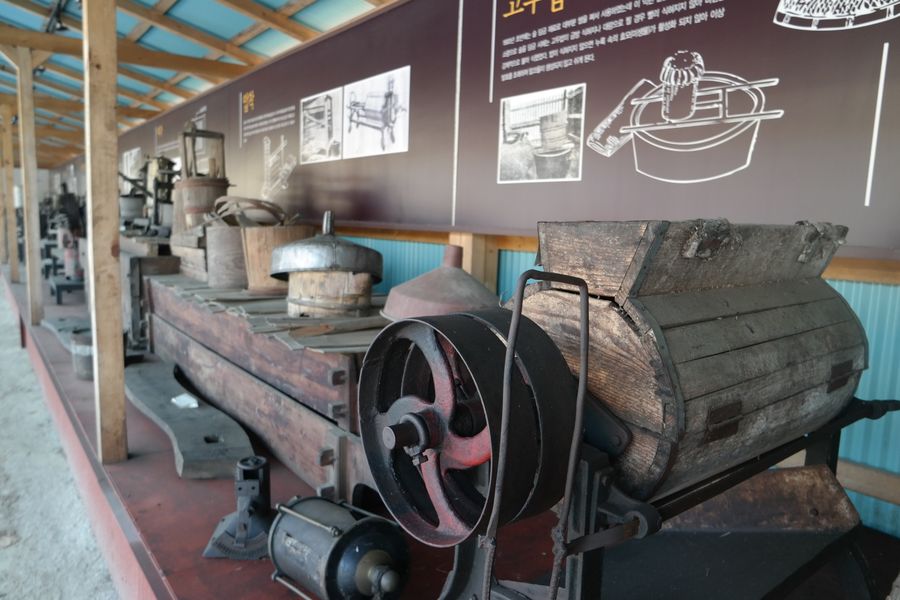
They seem abandoned under white dust but they must be nice hard-working boys who used to work everyday under the instruction of one master craftsman.

Everything has its meaning but the thing that attracts most of visitors must be the maze of big pots lining in a row, Sewollang.

This place that 500 pots as big as an adult’s body lining up in lines like a maze is attractive enough to catch visitors’ eyes but it also represents Sansawon.

Sewollang was built that it has no wall using 88 pine tree pillars based on Haeinsa Beopgye-do and the pots are standing in line in every direction that look spectacular.

The big pots have symbolic meaning of architectural beauty and the surprising thing is that distilled liquor is aging inside them.

Plus various things are hidden in every corner of this maze with each theme. And when a tourist approaches, it automatically shows its theme and explanations.

The seemingly maze-like byways were actually a path that connects the entrance and exit for visitors to follow and look at the pots on their way. So if you just follow the pots from the entrance, you’ll look around the place.

Hundreds of pots are all brown but there’s only one that’s covered with white in the middle. On the outside of that big pot, so many messages were written by the people who’ve been here.

The bell above our heads chiming as it is played by cold wind along with fish-shaped sculptures gave great picturesqueness to the scene.

If you walk along the maze, you’ll get to the middle of the maze. There’s a round table in the middle that I don’t know it is for. But the lower part seems strange.

If you look at it closely thinking that it’s just a strange-shaped brick, it’s a strange surface of a wall that is made of black bottles stuck upside down on plastic bottles. These must be liquor bottles right?

Three wooden pillars at the back are chosen because they are crooked to indicate the shape of stream(川) according to the theory of divination based on topography.

If you pass the three pillars that look like a letter, you’ll see a big garden and Korean traditional buildings. That two-story building is the biggest Korean traditional buildings in this area.

I don’t know what they’re for but the tables inside seem like this place is open for the public for activities. But there was a big locker when I was there.

So we headed to the two-storied pavilion called Ugokru that’s open to public all the time. I don’t know if it’s frozen a bit or I weigh too much but the wooden steps make noise whenever I move my step.

But as soon as I looked down the front yard, I could get a clear view of Mount Unak in front of me. The view here when the fog is spreading over Unak Mountain, one of 5 Ak mountains in Gyeonggi-do, is known as the best view here.
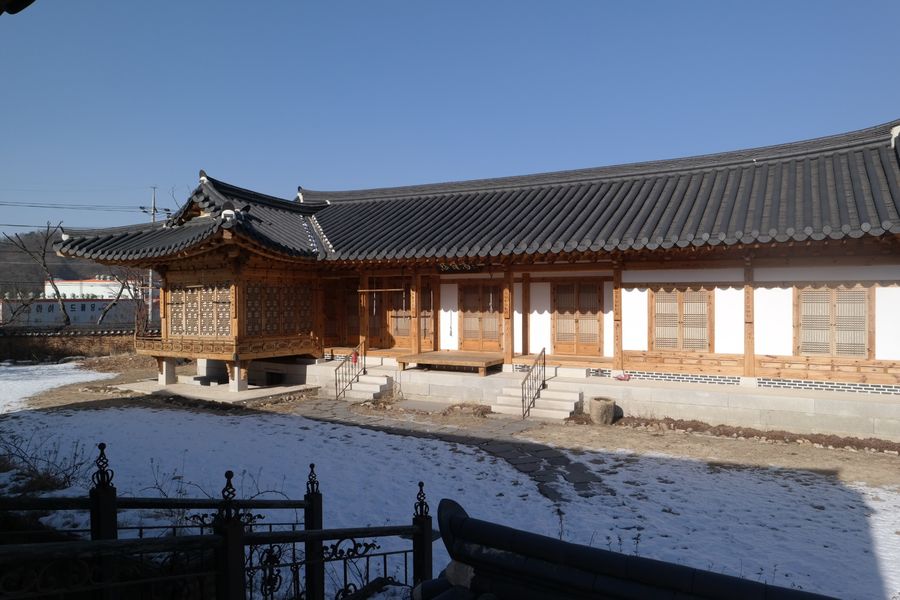
There’s building called Jaseongjae that imitated Nakseonjae of Changdeokgung Palace. It’s known that the food and liquor is fermented with suljigemi(rice-wine filter cake) in the basement but it’s closed to the public so I could not look inside.

To the right of the pavilion, there’s Yusanggoksu that is similar shape of Poseokjeong Pavilion in Gyeongju covered with snow instead of water. You gotta make a poem as you float a boat with a liquor cup at the entrance until it gets to the end, which takes approximately 1 minute. Is it possible?

To the right of front yard of the pavilion, there’s a building named Chuiseongak along with a pond. At this place, you can share a cup of tea, a cup of liquor under the breeze while you can enjoy the view when you open up the windows that were modeled after Soswaewon Gwangpunggak Pavilion, traditional garden in Damyang that we visited once.

The building standing alone on the opposite site is called Buandang, a warehouse of the rich man in Buan of Jeollabukdo moved here. The original frame, except for repaired parts, remains since it was built in 1877, which means it’s 130 years old, where there is a modern brewery distillery and articles owned by Makgeolli brewery were displayed.

And there were 12 May trees were planted that are 12 years old that this place was named after. If it was warmer, it would be a nice place to take a rest not just for viewing.
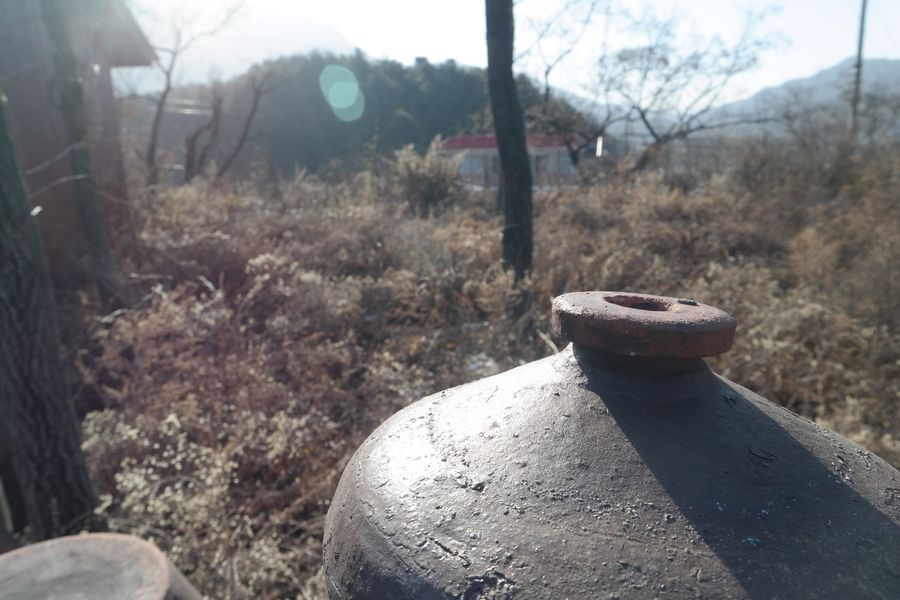
They say so many countries including Japan have been showing interests in Korean liquors since a few years ago. Especially Makgeolli has been loved by young people. If you have any foreign friends or if you have a chance to go to Pocheon, don’t hesitate to visit Sansawon where there are things to see and enjoy, and taste Korean traditional liquors and enjoy the tast for the arts.
Map : link
Address : 512, Hwahyeon-ri, Hwahyeon-myeon, Pocheon-si, Gyeonggi-do
Telephone : 031-531-9300
Operating Hours : 08:30~17:30
Admission Fee : Adult 2,000 won / Minor Free
Website : website










